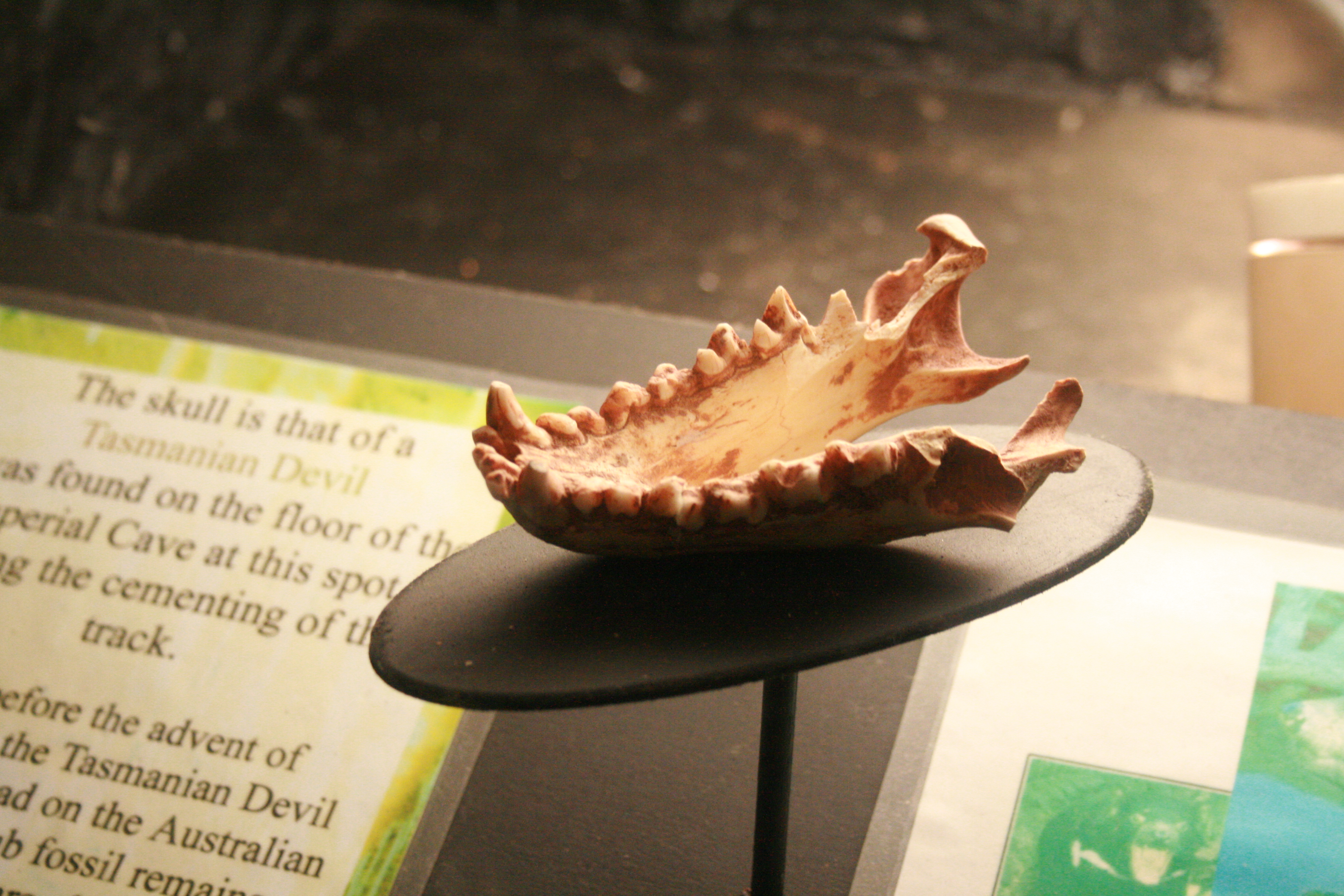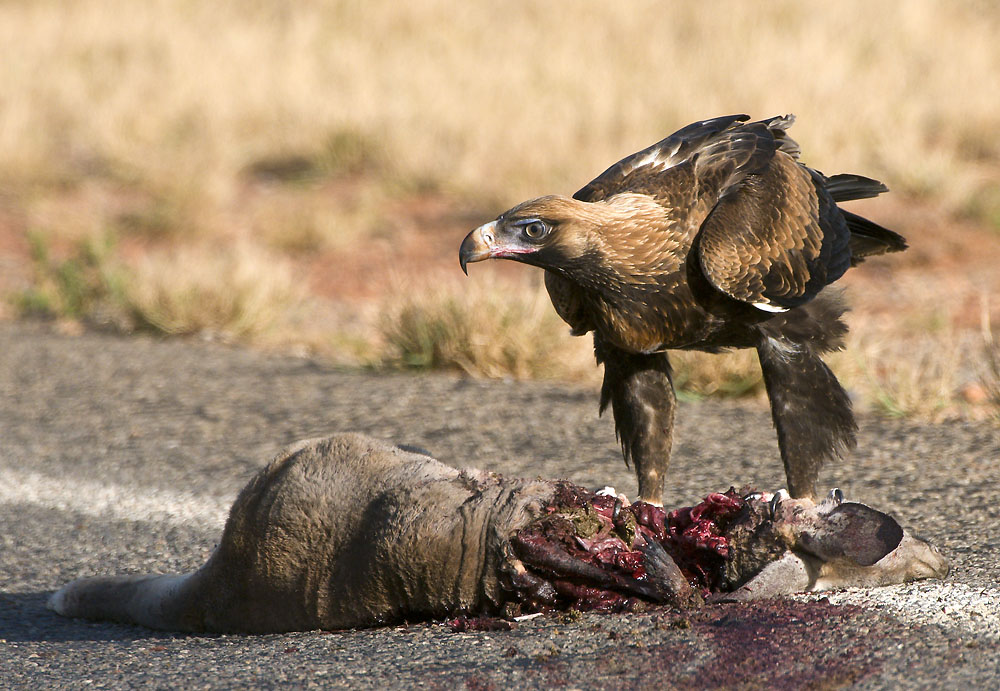|
Tasmanian Devil
The Tasmanian devil (''Sarcophilus harrisii'') (palawa kani: purinina) is a carnivorous marsupial of the family Dasyuridae. Until recently, it was only found on the island state of Tasmania, but it has been reintroduced to New South Wales in mainland Australia, with a small breeding population. The size of a small dog, the Tasmanian devil became the largest carnivorous marsupial in the world following the extinction of the thylacine in 1936. It is related to quolls, and distantly related to the thylacine. It is characterised by its stocky and muscular build, black fur, pungent odour, extremely loud and disturbing screech, keen sense of smell, and ferocity when feeding. The Tasmanian devil's large head and neck allow it to generate among the strongest bites per unit body mass of any extant predatory land mammal. It hunts prey and scavenges on carrion. Although devils are usually solitary, they sometimes eat and defecate together in a communal location. Unlike most other da ... [...More Info...] [...Related Items...] OR: [Wikipedia] [Google] [Baidu] |
Largest Mammals
The following is a list of largest mammals by family. Tenrecs and allies (Afrosoricida) *The largest of these insectivorous mammals is the giant otter shrew (''Potamogale velox''), native to Central Africa. This species can weigh up to and measure in total length. Even-toed ungulates (Artiodactyla) *The largest species in terms of weight is the hippopotamus (''Hippopotamus amphibius''), native to the rivers of sub-Saharan Africa. They can attain a size of , long and tall. Prehistoric hippos such as '' H. gorgops'' and '' H. antiquus'' rivaled or exceeded the modern species as the largest members of the family and order to ever exist. *The longest-bodied species, and tallest of all living land animals, is the giraffe (''Giraffa sp.''), measuring up to tall to the top of the head, and despite being relatively slender, reaching a top weight of . *The largest extant representative of the bovids, a diverse and well-known family, is the Asian forest-dwelling gaur (''Bos ga ... [...More Info...] [...Related Items...] OR: [Wikipedia] [Google] [Baidu] |
Carrion
Carrion () is the decaying flesh of dead animals, including human flesh. Overview Carrion is an important food source for large carnivores and omnivores in most ecosystems. Examples of carrion-eaters (or scavengers) include crows, vultures, condors, hawks, eagles, hyenas, Virginia opossum, Tasmanian devils, coyotes and Komodo dragons. Many invertebrates, such as the carrion and burying beetles, as well as maggots of calliphorid flies (such as one of the most important species in '' Calliphora vomitoria'') and flesh-flies, also eat carrion, playing an important role in recycling nitrogen and carbon in animal remains. Carrion begins to decay at the moment of the animal's death, and it will increasingly attract insects and breed bacteria. Not long after the animal has died, its body will begin to exude a foul odor caused by the presence of bacteria and the emission of cadaverine and putrescine. Some plants and fungi smell like decomposing carrion and attract in ... [...More Info...] [...Related Items...] OR: [Wikipedia] [Google] [Baidu] |
Devil Facial Tumour Disease
Devil facial tumour disease (DFTD) is an aggressive non-viral clonally transmissible cancer which affects Tasmanian devils, a marsupial native to Australia. DFTD was first described in 1996. In the subsequent decade the disease ravaged Tasmania's wild devils. Affected high-density populations had up to 100% mortality in 12–18 months. Between 1996 and 2015, DFTD wiped out 95% of affected populations. Clinical signs There is often more than one primary tumour. Visible signs of DFTD begin with lumps of soft tissue around the mouth, which ulcerate. Tumours are locally aggressive, destroying the underlying bone of the jaw which interferes with feeding. Tumours may also cover the eyes. Devils usually die within six months from organ failure, secondary infection, or metabolic starvation. DFTD is rare in juveniles. It affects males and females equally. Transmission The most plausible route of transmission is through biting, particularly when canine teeth come into direct contact wit ... [...More Info...] [...Related Items...] OR: [Wikipedia] [Google] [Baidu] |
Holocene
The Holocene ( ) is the current geological epoch. It began approximately 11,650 cal years Before Present (), after the Last Glacial Period, which concluded with the Holocene glacial retreat. The Holocene and the preceding Pleistocene together form the Quaternary period. The Holocene has been identified with the current warm period, known as MIS 1. It is considered by some to be an interglacial period within the Pleistocene Epoch, called the Flandrian interglacial.Oxford University Press – Why Geography Matters: More Than Ever (book) – "Holocene Humanity" section https://books.google.com/books?id=7P0_sWIcBNsC The Holocene corresponds with the rapid proliferation, growth and impacts of the human species worldwide, including all of its written history, technological revolutions, development of major civilizations, and overall significant transition towards urban living in the present. The human impact on modern-era Earth and its ecosystems may be considered of global ... [...More Info...] [...Related Items...] OR: [Wikipedia] [Google] [Baidu] |
Australian Government
The Australian Government, also known as the Commonwealth Government, is the national government of Australia, a federal parliamentary constitutional monarchy. Like other Westminster-style systems of government, the Australian Government is made up of three branches: the executive (the prime minister, the ministers, and government departments), the legislative (the Parliament of Australia), and the judicial. The legislative branch, the federal Parliament, is made up of two chambers: the House of Representatives (lower house) and Senate (upper house). The House of Representatives has 151 members, each representing an individual electoral district of about 165,000 people. The Senate has 76 members: twelve from each of the six states and two each from Australia's internal territories, the Australian Capital Territory and Northern Territory. The Australian monarch, currently King Charles III, is represented by the governor-general. The Australian Government in its exec ... [...More Info...] [...Related Items...] OR: [Wikipedia] [Google] [Baidu] |
Looney Tunes
''Looney Tunes'' is an American animated comedy short film series produced by Warner Bros. starting from 1930 to 1969, concurrently with its partner series '' Merrie Melodies'', during the golden age of American animation.Looney Tunes . ''www.bcdb.com'', April 12, 2012 Then some new cartoons were produced from the late 1980s to the mid 2010s as well as other made productions beginning in 1972. The two series introduced a large cast of characters, including Bugs Bunny, Daffy Duck, and |
Tasmanian Devil (Looney Tunes)
The Tasmanian Devil (also spelled Tazmanian Devil), commonly referred to as Taz, is an animated cartoon character featured in the Warner Bros. ''Looney Tunes'' and ''Merrie Melodies'' series of cartoons. Though the character appeared in only five shorts before Warner Bros. Cartoons shut down in 1964, marketing and television appearances later propelled Taz to new popularity in the 1990s. Personality Taz is generally portrayed as a ferocious, albeit dim-witted, carnivore with a notoriously short temper and little patience. He got his name in the short '' Ducking the Devil,'' where he is described as a "vicious, evil-tempered brute with jaws like a steel trap". Though he can be very devious, he is also sweet at times. His enormous appetite seems to know no bounds, as he will eat anything in his path. He is best known for his speech consisting mostly of grunts, growls, and rasps (in his earlier appearances, he does speak English with primitive grammar) as well as his ability to ... [...More Info...] [...Related Items...] OR: [Wikipedia] [Google] [Baidu] |
Phalangeriformes
Phalangeriformes is a paraphyletic suborder of about 70 species of small to medium-sized arboreal marsupials native to Australia, New Guinea, and Sulawesi. The species are commonly known as possums, gliders, and cuscus. The common name "possum" for various Phalangeriformes species derives from the creatures' resemblance to the opossums of the Americas (the term comes from Powhatan language ''aposoum'' "white animal", from Proto-Algonquian *''wa·p-aʔɬemwa'' "white dog"). However, although opossums are also marsupials, Australasian possums are more closely related to other Australasian marsupials such as kangaroos. Phalangeriformes are quadrupedal diprotodont marsupials with long tails. The smallest species, indeed the smallest diprotodont marsupial, is the Tasmanian pygmy possum, with an adult head-body length of and a weight of . The largest are the two species of bear cuscus, which may exceed . Phalangeriformes species are typically nocturnal and at least partia ... [...More Info...] [...Related Items...] OR: [Wikipedia] [Google] [Baidu] |
George Prideaux Robert Harris
George Prideaux Robert Harris (1775–1810) was the deputy surveyor in the early days of Van Diemen's Land (now Tasmania), Australia, from settlement in 1803 until his death in Hobart Town in 1810. He was also an explorer, artist and naturalist who described many of the plants and marsupials native to the Island, including the Tasmanian devil and the thylacine The thylacine ( , or , also ) (''Thylacinus cynocephalus'') is an extinct carnivorous marsupial that was native to the Australian mainland and the islands of Tasmania and New Guinea. The last known live animal was captured in 1930 in Tas .... References 1775 births 1810 deaths Australian naturalists Australian zoologists {{Australia-scientist-stub ... [...More Info...] [...Related Items...] OR: [Wikipedia] [Google] [Baidu] |
Zoological Society Of London
The Zoological Society of London (ZSL) is a charity devoted to the worldwide conservation of animals and their habitats. It was founded in 1826. Since 1828, it has maintained the London Zoo, and since 1931 Whipsnade Park. History On 29 November 1822, the birthday of John Ray, "the father of modern zoology", a meeting held in the Linnean Society in Soho Square led by Rev. William Kirby, resolved to form a "Zoological Club of the Linnean Society of London". Between 1816 and 1826, discussions between Stamford Raffles, Humphry Davy, Joseph Banks and others led to the idea that London should have an establishment similar to the Jardin des Plantes in Paris. It would house a zoological collection "which should interest and amuse the public." The society was founded in April 1826 by Sir Stamford Raffles, the Marquess of Lansdowne, Lord Auckland, Sir Humphry Davy, Robert Peel, Joseph Sabine, Nicholas Aylward Vigors along with various other nobility, clergy, and natu ... [...More Info...] [...Related Items...] OR: [Wikipedia] [Google] [Baidu] |
Common Wombat
The common wombat (''Vombatus ursinus''), also known as the coarse-haired wombat or bare-nosed wombat, is a marsupial, one of three extant species of wombats and the only one in the genus ''Vombatus''. The common wombat grows to an average of long and a weight of . Taxonomy The common wombat was first described by George Shaw in 1800. There are three extant subspecies: *Bass Strait (common) wombat (''V. u. ursinus''), the nominate form, was once found throughout the Bass Strait Islands, but is now restricted to Flinders Island to the north of Tasmania. Its population was estimated at 4,000 in 1996 and is listed as vulnerable by the Environment Protection and Biodiversity Conservation Act 1999 and IUCN Red List. *Hirsute wombat (''V. u. hirsutus'') is found on the Australian mainland. *Tasmanian wombat (''V. u. tasmaniensis'') is found in Tasmania. It is smaller than ''V. u. hirsutus''. Hackett's wombat (''V. hacketti'') is an extinct species of genus ''Vombatus'', inha ... [...More Info...] [...Related Items...] OR: [Wikipedia] [Google] [Baidu] |
George Shaw (biologist)
George Kearsley Shaw (10 December 1751 – 22 July 1813) was an English botanist and zoologist. Life Shaw was born at Bierton, Buckinghamshire, and was educated at Magdalen Hall, Oxford, receiving his M.A. in 1772. He took up the profession of medical practitioner. In 1786 he became the assistant lecturer in botany at the University of Oxford. He was a co-founder of the Linnean Society in 1788, and became a fellow of the Royal Society in 1789. In 1791 Shaw became assistant keeper of the natural history department at the British Museum, succeeding Edward Whitaker Gray as keeper in 1806. He found that most of the items donated to the museum by Hans Sloane were in very bad condition. Medical and anatomical material was sent to the museum at the Royal College of Surgeons, but many of the stuffed animals and birds had deteriorated and had to be burnt. He was succeeded after his death by his assistant Charles Konig. Works Shaw published one of the first English descrip ... [...More Info...] [...Related Items...] OR: [Wikipedia] [Google] [Baidu] |










